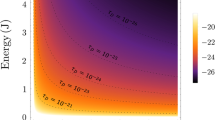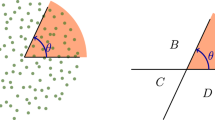Abstract
Space-time ‘foam’ is a geometric picture of the smallest size scales in the Universe, which is characterized mainly by the presence of quantum uncertainties in the measurement of distances. All quantum-gravity theories should predict some kind of foam1,2, but the description of the properties of this foam varies according to the theory, thereby providing a possible means of distinguishing between such theories. I previously showed3 that foam-induced distance fluctuations would introduce a new source of noise to the measurements of gravity-wave interferometers, but the theories are insufficiently developed4 to permit detailed predictions that would be of use to experimentalists. Here I propose a phenomenological approach that directly describes space-time foam, and which leads naturally to a picture of distance fluctuations that is independent of the details of the interferometer. The only unknown in the model is the length scale that sets the overall magnitude of the effect, but recent data5 already rule out the possibility that this length scale could be identified with the ‘string length’ (10-34 m < Ls < 10-33 m). Length scales even smaller than the ‘Planck length’ (LP ≈ 10-35 m) will soon be probed experimentally.
This is a preview of subscription content, access via your institution
Access options
Subscribe to this journal
Receive 51 print issues and online access
$199.00 per year
only $3.90 per issue
Buy this article
- Purchase on Springer Link
- Instant access to full article PDF
Prices may be subject to local taxes which are calculated during checkout

Similar content being viewed by others
References
Wheeler, J. A. From relativity to mutability. Revista Mexicana De Fisica 23, 1–57 (1974).
Hawking, S. W. Spacetime foam. Nuc. Phys. B 144, 349–362 (1978).
Amelino-Camelia, G. Gravity-wave interferometers as quantum-gravity detectors. Nature 398, 216–218 (1999).
Amelino-Camelia, G. Gravity-wave interferometers as probes of a low-energy effective quantum gravity. Phys. Rev. D 62, 024015-1–024015-18 (2000).
Abramovici, A. et al. Improved sensitivity in a gravitational wave interferometer and implications for LIGO. Phys. Lett. A 218, 157–163 (1996).
Ahluwalia, D. V. Quantum gravity: testing time for theories. Nature 398, 199 (1999).
Ng, Y. J. & van Dam, H. Measuring the foaminess of space-time with gravity-wave interferometers. Found. Phys. 30, 795–805 (2000).
Amelino-Camelia, G. Are we at the dawn of quantum-gravity phenomenology? Lect. Notes Phys. 541, 1–49 (2000).
Green, M. B., Schwarz, J. H. & Witten, E. Superstring Theory (Cambridge Univ. Press, Cambridge, 1987).
Polchinski, J. String Theory (Cambridge Univ. Press, Cambridge, 1998).
Ashtekar, A. Quantum mechanics of geometry. Preprint gr-qc/9901023 at 〈xxx.lanl.gov〉 (1999).
Gaul, M. & Rovelli, C. Loop quantum gravity and the meaning of diffeomorphism invariance. Lect. Notes Phys. 541, 277–324 (2000).
Smolin, L. The new universe around the next corner. Phys. World 12, 79–84 (1999).
Ellis, J., Hagelin, J. S., Nanopoulos, D. V. & Srednicki, M. Search for violations of quantum mechanics. Nucl. Phys. B 241, 381–405 (1984).
Kostelecky, V. A. & Potting, R. CPT, strings, and meson factories. Phys. Rev. D 51, 3923–3935 (1995).
Huet, P. & Peskin, M. E. Violation of CPT and quantum mechanics in the K0 - K̄0 system. Nucl. Phys. B 434, 3–38 (1995).
Ellis, J., Lopez, J., Mavromatos, N. E., Nanopoulos, D. & the CPLEAR Collaboration. Test of CPT symmetry and quantum mechanics with experimental data from CPLEAR. Phys. Lett. B 364, 239–245 (1995).
Amelino-Camelia, G., Ellis, J., Mavromatos, N. E., Nanopoulos, D. & Sarkar, S. Tests of quantum gravity from observations of γ-ray bursts. Nature 393, 763–765 (1998).
Saulson, P. R. Fundamentals of Interferometric Gravitational Wave Detectors (World Scientific, Singapore, 1994).
Radeka, V. Low-noise techniques in detectors. Annu. Rev. Nucl. Part. Sci. 38, 217–277 (1988).
Garay, L. J. Space-time foam as a quantum thermal bath. Phys. Rev. Lett. 80, 2508–2511 (1998).
Astone, P. et al. Upper limit for a gravitational-wave stochastic background with the EXPLORER and NAUTILUS resonant detectors. Phys. Lett. B 385, 421–424 (1996).
Maggiore, M. Gravitational wave experiments and early universe cosmology. Phys. Rep. 331, 283–367 (2000).
Abramovici, A. et al. LIGO: The laser interferometer gravitational-wave observatory. Science 256, 325–333 (1992).
Caron, B. et al. The Virgo interferometer. Class. Quantum Grav. 14, 1461–1469 (1997).
Danzmann, K. LISA: Laser interferometer space antenna for gravitational wave measurements. Class. Quantum Grav. 13, A247–A250 (1996).
't Hooft, G. Quantum gravity as a dissipative deterministic system. Class. Quantum Grav. 16, 3263–3279 (1999).
Amelino-Camelia, G. Space-time foam. Preprint gr-qc/0104005 at 〈http://xxx.lanl.gov/〉; (2001).
Author information
Authors and Affiliations
Corresponding author
Rights and permissions
About this article
Cite this article
Amelino-Camelia, G. A phenomenological description of space-time noise in quantum gravity. Nature 410, 1065–1067 (2001). https://doi.org/10.1038/35074035
Received:
Accepted:
Issue Date:
DOI: https://doi.org/10.1038/35074035
This article is cited by
-
Emergence of cosmic space and minimal length in quantum gravity: a large class of spacetimes, equations of state, and minimal length approaches
Indian Journal of Physics (2016)
-
Corrections to the Hawking Tunneling Radiation from MDR
International Journal of Theoretical Physics (2016)
-
Radiation of charged black holes and modified dispersion relation
General Relativity and Gravitation (2016)
-
Black hole thermodynamics with a modified dispersion relation admitting minimal length and maximal momentum
Astrophysics and Space Science (2015)
-
Quantum Corrections for a Black Hole in an Asymptotically Safe Gravity with Higher Derivatives
International Journal of Theoretical Physics (2012)
Comments
By submitting a comment you agree to abide by our Terms and Community Guidelines. If you find something abusive or that does not comply with our terms or guidelines please flag it as inappropriate.



